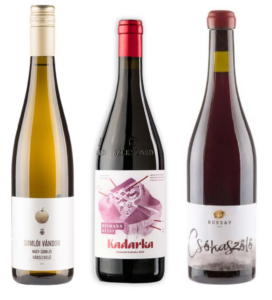Deep Roots, Bright Future: Autochthonous Grape Varieties of Hungary
Beyond Furmint a number of lesser-known, autochthonous varieties — from Hárslevelű to Kadarka and Csókaszőlő — are carving out their place in the spotlight.
Back in the early nineties, when, after the Communist era, vineyards were replanted and wineries reborn in Hungary, most producers chose international grape varieties like Merlot, Cabernet Franc, and — despite the warm and warming climate — even Pinot Noir was shining. Then, as the wines of Hungary were welcomed by consumers, and a new generation of winemakers returned home from abroad with freshly gained knowledge, more and more of them decided to turn back to indigenous grape varieties, some even dating back to the pre-phylloxera era. Time proved they were right to do so, as today, characterful wines of indigenous origin are shining brighter than ever.

Tokaj’s Second Favourite: Hárslevelű
 is gaining popularity without any doubt: the second grape variety of Tokaj is becoming increasingly well known. However, this was not always the case. Despite the fact that its roots go back to the Middle Ages, just before phylloxera it almost became extinct — thanks to a regulation that declared Hárslevelű must go. Luckily, producers changed their minds and replanted it after phylloxera hit — and not only in Tokaj.
is gaining popularity without any doubt: the second grape variety of Tokaj is becoming increasingly well known. However, this was not always the case. Despite the fact that its roots go back to the Middle Ages, just before phylloxera it almost became extinct — thanks to a regulation that declared Hárslevelű must go. Luckily, producers changed their minds and replanted it after phylloxera hit — and not only in Tokaj.
It is planted throughout the Upper Hungary wine region (including Eger, Mátra and Bükk), as well as the Balaton area: the most complex examples come from the basalt-rich Somló. Interestingly enough, there is absolutely no historic evidence that Hárslevelű existed here before phylloxera. As local winemaker, Zoltán Balogh (Somlói Apátsági Pincészet) says, the farmers may have replanted it simply because they needed an aromatic grape variety.
Hárslevelű is certainly capable of producing floral and honey-toned, let’s call them semi-aromatic wines — making it the perfect blending partner for the more neutral Furmint. But with care, it can go far beyond that. On its own, it can be medium to full-bodied, and as it is mostly grown on volcanic terroir, it often expresses a distinctive mineral character.
Fun fact: it is also planted in South Africa, and more producers are adding it to their portfolios.
From Hungary: Tokaj Kikelet and Somlói Vándor are two great examples producing mineral-driven, complex, vibrant single-varietal wines from this grape.
Kadarka, the Hungarian Pinot Noir
I do not like comparisons, but with Kadarka it is hard to avoid. Not only in the aromatic profile, but also in its sensitive growing conditions, Kadarka is similar to Pinot Noir.
Sharing its past with Balkan countries, the grape variety was introduced to Hungary in the 16th–17th century. Kadarka flourished in the southern regions of the Kingdom of Hungary, becoming the dominant red grape by the 19th century. It was the soul of the famous Bikavér blends, and a varietal wine in its own right. However, during the Communist era, its thin skins and irregular ripening made it unfashionable.
Zoltán Heimann, the younger member of the Heimann family, is one of the leading revivalists of this grape. You can find him online under the name Kadarka Man — he has done a great deal to bring the variety back into the spotlight. Kadarka is mid to late ripening, and due to its thin skin is prone to botrytis and rot, so careful canopy management is more than essential. It is destined for hand-picking, as selection is a crucial element in producing a wine that is light to medium-bodied, with bright acidity and aromas of rosehip, sour cherry, redcurrants, and white pepper.
Alongside Heimann, try Vida, Márkvárt, or Sziegl — especially if you’re curious how Kadarka shows in a red Aszú-style interpretation. While the latter is not located in Szekszárd, the others are — and there’s little doubt that Kadarka performs best on the loess soils of this region. You’ll also find it planted in Upper Hungary and around Lake Balaton, where it expresses a different character thanks to volcanic soils.
The Most Famous Black Bird: Csókaszőlő
 Speaking of great revivalists, József Szentesi is impossible to overlook. A true legend in Hungarian winemaking, he has brought countless rare indigenous grape varieties back into the spotlight. Today, any winemaker in Hungary looking for a cutting of a special cultivar is likely to turn to him. His name has become almost synonymous with Csókaszőlő — which, charmingly, translates to “jackdaw vine”.
Speaking of great revivalists, József Szentesi is impossible to overlook. A true legend in Hungarian winemaking, he has brought countless rare indigenous grape varieties back into the spotlight. Today, any winemaker in Hungary looking for a cutting of a special cultivar is likely to turn to him. His name has become almost synonymous with Csókaszőlő — which, charmingly, translates to “jackdaw vine”.
As legend has it, when Budapest still had vineyards, the famous Budai Vörös (Buda Red) cuvée was made from Csókaszőlő and Kadarka. Like many traditional varieties, Csókaszőlő nearly became extinct due to the upheavals of the 20th century — until József Szentesi recognised its potential. And while it is far from widely planted even today, in recent years it has been gaining more and more attention as a single-varietal wine.
The grape itself is thick-skinned, offering good resistance to disease. It has a deep ruby colour, is medium-bodied, with vivid acidity and moderate tannins. Aromas of blackcurrant, blueberry, sour cherry, along with subtle spice and earthy, herbal notes, allow for the production of a well-structured, complex red wine with significant ageing potential.
Alongside Szentesi (based in the Etyek wine district), try Vylyan (Villány), 2HA, or Bussay (both in Balaton).
